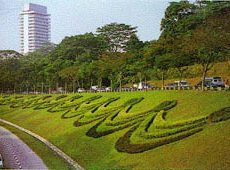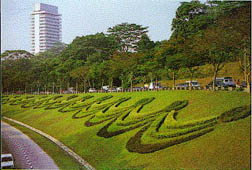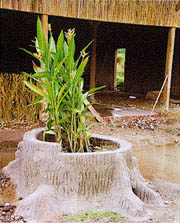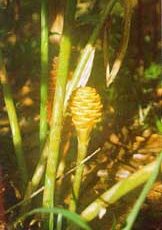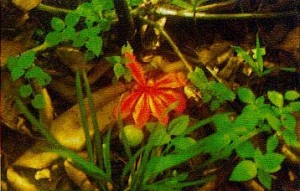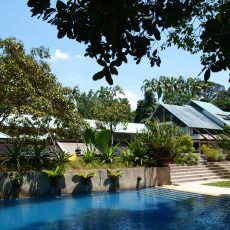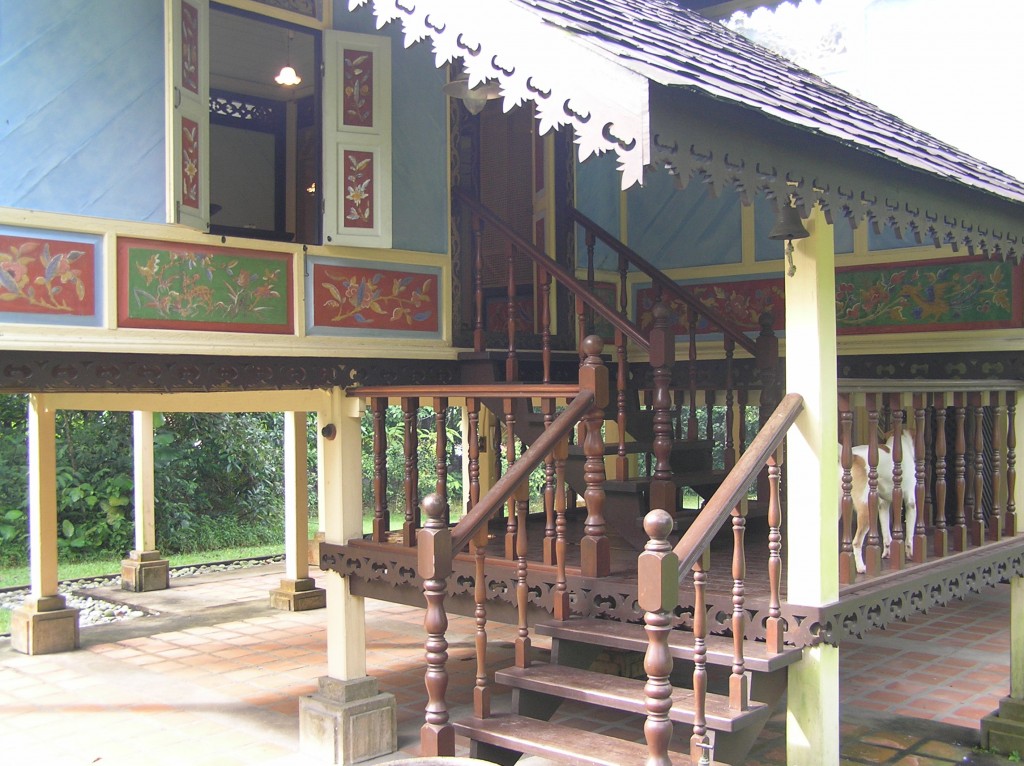by Angela Hijjas
for The Malaysian Naturalist, vol. 51 no. 2, December 1997.
The name ‘Taman Sari’ evokes the fragrance and grace of a lush Javanese garden, with bees probing for nectar in masses of flowers. The first Sultan of Jogjakarta, Mangkubumi, the ‘guardian of the earth,’ chose the name for the walled pleasure garden adjoining his kraton in the mid-eighteenth century. He spared no expense on walls, tunnels and waterworks, while the Dutch complained that he placed more priority on this self-indulgence than on their fortifications. If only all kings were so wise!
The intricate irrigation channels of the original Taman Sari flowed through a series of pools and courtyards, complete with a fountain of youth, the Umbul Binangan. Spice, vegetable and fruit gardens, terraces, staircases and pavilions made up what must have been a wonder of its time. But the beauty of any garden is transitory; earthquakes and neglect reduced this garden to ruin by the end of the century and today all that remains are walls and a labyrinth of sunken passages.
Two centuries later, inspired by the romance of Javanese palaces, I adopted the name Taman Sari for my herb garden. Like the Sultan, I wanted the garden to be an integral part of our home, while developing a strong sense of its place within Malaysia. The most promising site for it lay behind the house, an area of about half an acre.
The so-called ‘hard landscaping’ elements, the paths, furniture and sculpture, are an essential part of any garden, particularly a herb garden, and their added detail helps to compensate for the predominant lack of colour in Southeast Asian species. As the herb garden is a meld of East and West, the landscape design laid out the paths and beds in the European style, with crossed paths dividing the area into four quarters. Bali supplied the stone sculptures of winged lions for the entrance and a garuda to animate the garden, providing an aesthetic and spiritual link to the animist past. The pathways themselves are pure KL, the indispensable interlocking concrete pavers: cheap, durable and practical.
My criteria for selecting plants were that they either be Southeast Asian in origin, or of some culinary or medicinal significance in the region. Flowers with characteristic Asian fragrances are another feature. Half the garden was to be for useful plants, and the other for more sensual pleasure. Inevitably, this separation has become very blurred, especially since we started companion planting in the vegetable garden, using the pungency of the herbs to protect vulnerable vegetables from insect attack.
I resisted the urge to fill the space with trees as most vegetables need full sun, but some shade is provided by the garden’s main ‘structural’ trees and this creates a variety of habitats. A single tamarind tree is as the centre of the vegetable garden, while the main path is protected by rows of nutmeg and meninjau trees. The entrance is shaded by pinang palms whose narrow canopies do not block too much sun. Another row cinkeh, cloves, has been more difficult to establish and only one tree has done well, but it is backed by a hedge of kemuning, with its periodic flushes of fragrant blossoms. A row of Borassus flabiliffer, the lontar palm, will ultimately provide a source for the toddy of my old age, assuming there is someone around who can still tap by the year 2020. A row of cinnamon trees separates the garden from the old durian orchard and completes the structural framework, leaving plenty of space for the herbs, vegetables, fragrant flowers and medicinal plants that I am still collecting.
While the major plants anchor the structural design of the garden, the smaller ones provide detail and interest which can be manipulated in many way. With the larger trees providing shade, different layers can be planted through and underneath. Vanilla orchids, pepper and sireh climb the trunks, shrubby ground cover is provided by shade-tolerant pandanusi, gingers or costus, while kadok and pegaga are strong covers for shade and sun respectively.
As our land has been a coffee plantation for many years before we acquired it, and because I am interested in the continuity of landscapes, I planted some coffee as a hedge outside Taman Sari before I discovered that coffee flowers have perhaps the most beautiful of all fragrances. The blooming lasts for just a few days ever few months, but the perfume is unforgettable. Other perfumes come from the kenanga, jasmines and gingers, and the many varieties of leaves that have to be crushed to release their fragrant oils. To add to the confusion, occasionally different plants have similar smells: my plot of pandanus (whose smell is only released in cooking) is overhung by kerak nasi, whose perfume is just like pandanus. Many visitors, smelling kerak nasi mistake it for the better-known culinary ingredient.
Some foreign plants, like aloe vera, have become essential medicinal ingredients; they can tolerate full sun and a dry position. But I have given up trying to grow European herbs like rosemary and thyme, as the rain devastates them; they would probably do better in pots. Lemon balm is a useful exception. Other foreign plants that are widely used for herbal preparations, like elderberry (Sambucus nigra) have local equivalents: the entire plant of Sambucus javanica can be used for similar medicinal preparations as the European variety.
Apart from a few simple cold remedies, I haven’t made use of my plants and have collected them purely for the pleasure of seeing them all growing together, appreciating their histories (the tales about nutmeg alone fill volumes), and enjoying the delight of sharing them with others. An evening wander around the paths, interrupted by tastes and smells, is fun and enlightening, particularly for city children, and there is nothing like perfume or flavour to transport you to another part of the world. ‘My Mum uses this’ and ‘my grandfather grew that’ are frequent comments, and even I, from Australia, instantly recall the hot summer nights at my grandparents’ home every time I break a stalk of serai wangi, the citronella that was widely used as an insect repellent in the Fifties and is now in demand again with the organic revival.
We have plenty of kitchen herbs: chilli, serai (lemon grass), limau purut, kasturi and nipis, kunyit (turmeric), curry leaf, lengkuas (galingal), ketumbar (coriander) and mint all do well. Little can substitute for the pleasure of a pungent tom yam made with home-grown ingredients. If the kitchen is the heart of the home, the Taman Sari is the heart of my garden. What better occupation could God have intended for Sultan or commoner?







